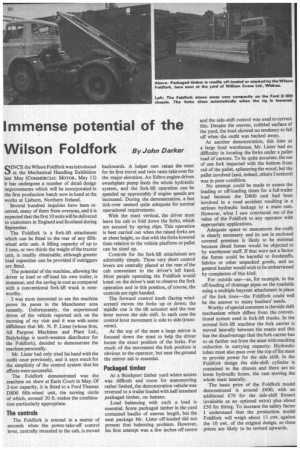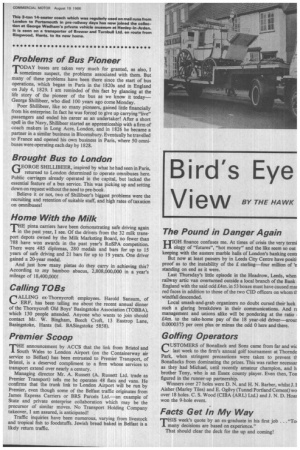Immense potential of the
Page 52

Page 53

If you've noticed an error in this article please click here to report it so we can fix it.
Wilson Foldfork By John Darker SINCE the Wilson Foldfork was introduced at the Mechanical Handling Exhibition last May (COMMERCIAL MOTOR, May 13) it has undergone a number of detail design improvements which will be incorporated in the first production batch now in hand at the works at Lisburn, Northern Ireland.
Several hundred inquiries have been received, many of them from overseas, and it is expected that the first 10 units will be delivered to customers in England and Scotland during September.
The Foldfork is a fork-lift attachment which can be fitted to the rear of any fifthwheel artic unit. A lifting capacity of up to 3 tons, or two thirds the weight of the tractor unit, is readily obtainable, although greater load capacities can be provided if outriggers are fitted.
The potential of the machine, allowing the driver to load or off-load his own trailer, is immense; and the saving in cost as compared with a conventional fork-lift truck is noteworthy.
I was most interested to see the machine prove its paces in the Manchester area recently. Unfortunately, the experienced driver of the vehicle reported sick on the morning of my visit and it was with some diffidence that Mr. N. P. Lister (whose firm, All Purpose Machines and Plant Ltd., Stalybridge is north-western distributor for the Foldfork), decided to demonstrate the machine personally.
Mr. Lister had only tried his hand with the outfit once previously, and it says much for the simplicity of the control system that his efforts were successful.
The Foldfork demonstrated was the machine on show at Earls Court in May. Of 2-ton capacity, it is fitted to a Ford Thames D800 fifth-wheel unit, the turning circle of which, around 30 ft. makes the combination particularly appropriate.
The controls The Foldfork is erected in a matter of seconds when the power-take-off control lever, centrally mounted in the cab, is moved backwards. A helper ram raises the mast for its first travel and twin rams take over for the major elevation. An Edbro engine-driven swashplate pump feeds the whole hydraulic system, and the fork-lift operation can be speeded up appreciably if engine speeds are Increased. During the demonstration, a fast tick-over seemed quite adequate for normal operational requirements.
With the mast vertical, the driver must leave his cab to fold down the forks, which are secured by spring clips. This operation is best carried out when the raised forks are at chest height, so that with the forks lowered their relation to the vehicle platform or pallet can be sized up.
Controls for the fork-lift attachment are admirably simple. Three very short control levers are centrally placed at the rear of the cab convenient to the driver's left hand. Most people operating the Foldfork would kneel on the driver's seat to observe the fork operation and in this position, of course, the controls are right handed.
The forward control knob (facing windscreen) moves the forks up or down; the middle one is the tilt actuator and the rear lever moves the side shift. In each case the control lever movement is side to side (transverse).
At the top of the mast a large mirror is focused down the mast to help the driver locate the exact position of the forks. For much of the movement the fork position is obvious to the operator, but near the ground the mirror aid is essential.
Packaged timber At a Stockport timber yard where access was difficult and room for manoeuvring rather limited, the demonstration vehicle was reversed to a trailer loaded with half standard packaged timber, on battens.
Load balancing with such a load is essential. Some packaged timber in the yard contained baulks of uneven length, but the neat package Mr. Lister off-loaded did not present that balancing problem. However, his first attempt was a few inches off centre and the side-shift control was used to correct this. Despite the uneven, cobbled surface of the yard, the load showed no tendency to fall off when the outfit was backed away.
At another demonstration, this time at a large food warehouse, Mr. Lister had no difficulty in locating the forks under a pallet load of cartons. To be quite accurate, the toe of one fork impacted with the bottom front rail of the pallet, splintering the wood, but the pallet involved (and, indeed, others I noticed) was in poor condition. No attempt could be made to assess the loading or off-loading times for a full trailer load because the D800 unit had been involved in a road accident resulting in a serious hydraulic leakage to a main ram. However, what I saw convinced me of the value of the Foldfork to any operator with appropriate applications.
Adequate space to manoeuvre the outfit is clearly necessary and its use in enclosed covered premises is likely to be minimal because diesel fumes would be objected to by warehouse staff. If that were not a factor the fumes could be harmful to foodstuffs, fabrics or other unpacked goods, and no general haulier would wish to be embarrassed by complaints of this kind.
For outside use—as, for example, in the off-loading of drainage pipes on the roadside using a multiple bayonet attachment in place of the fork tines—the Foldfork could well be the answer to many hauliers' needs.
Worthy of special comment is theside shift mechanism which differs from the conventional system used in fork-lift trucks. In the normal fork-lift machine the fork carrier is moved laterally between the masts and this has the disadvantage that the fork carrier has to sit farther out from the mast with resulting reduction in carrying capacity. Hydraulic tubes must also pass over the top of the mast to provide power for the side shift. In the Foldfork design the side-shift cylinder is contained in the chassis and there are no loose hydraulic hoses, the ram moving the whole mast laterally.
The basic price of the Foldfork model demonstrated is around £600, with an additional £70 for the side-shift fitment (available as an optional extra) plus about £50 for fitting. To increase the safety factor I understand that the production model Foldfork will weigh about 13 cwt. against the 10 cwt. of the original design, so these prices are likely to be revised upwards.
Problems of Bus Pioneer
TODAY buses are taken very much for granted, as also, I sometimes suspect, the problems associated with them. But many of these problems have been there since the start of bus operations, which began in Paris in the 1820s and in England on July 4, 1829, I am reminded of this fact by glancing at the life story of the pioneer of the bus as we know it today— George Shillibeer, who died 100 years ago come Monday. Poor Shillibeer, like so many pioneers, gained little financially from his enterprise. In fact he was forced to give up carrying "live" passengers and ended his career as an undertaker! After a short spell in the Navy, Shillibeer started an apprenticeship with a firm of coach makers in Long Acre, London, and in 1826 he became a partner in a similar business in Bloomsbury. Eventually he travelled to France and opened his own business in Paris, where 50 omnibuses were operating each day by 1828.
Brought Bus to London
GEORGE SHILLIBEER, inspired by what he had seen in Paris, returned to London determined to operate omnibuses here. Public carriages already operated in the capital, but lacked the essential feature of a bus service. This was picking up and setting down on request without the need to pre-book. Believe it or not, two of Shillibeer's biggest problems were the recruiting and retention of suitable staff, and high rates of taxation on omnibuses!
Home With the Milk
THE pinta carriers have been demonstrating safe driving again in the past year, I see. Of the drivers from the 32 milk transport depots owned by the Milk Marketing Board, no fewer than 788 have won awards in the past year's RoSPA competition. There were 485 diplomas, 280 medals and bars for up to 15 years of safe driving and 21 bars for up to 19 years. One driver gained a 20-year medal. And just how many pintas do they carry in achieving this? According to my bamboo abacus, 2,808,000,000 in a year's mileage of 18,400,000!
Calling TO Bs
CCALLING ex-Thornycroft employees. Harold Sansum, of ERF, has been telling me about the recent annual dinner of the Thornycroft Old Boys' Basingstoke Association (TOBBA), which 130 people attended. Anyone who wants to join should contact Mr. W. Bingham, Beech Croft, 13 Eastrop Lane, Basingstoke, Hants (tel. BASingstoke 5858).
Premier Scoop
THE announcement by ACCS that the link from Bristol and South Wales to London Airport (on the Containerway air service to Belfast) has been entrusted to Premier Transport, of Bristol, is a deserved compliment to a firm whose services to transport extend over nearly a century. Managing director Mr. A. Russett (A. Russett Ltd. trade as Premier Transport) tells me he operates 48 flats and vans. He confirms that the trunk link to London Airport will be run by Premier, even though some of the Belfast traffic originates from James Express Carriers or BRS Parcels Ltd.—an example of State and private enterprise collaboration which may be the precursor of similar maves. No Transport Holding Company takeover, I am assured, is anticipated! Traffic inquiries have been numerous, varying from livestock and tropical fish to foodstuffs. Jewish bread baked in. Belfast is a likely return traffic.
The Pound in Danger Again
HIGH finance confuses me. At times of crisis the very termi ology of "futures", "hot money" and the like seem so out keeping with the austere marble halls of London's banking centt But now at least passers by in Leeds City Centre have positi proof as to the instability of the £ sterling—four million of 'e standing on end as it were. Last Thursday's little episode in the Headrow, Leeds, when railway artic van overturned outside a local branch of the Bank England with the said odd £4m. in 53 boxes must have caused mai red faces in addition to those of the two CID officers on whom tl windfall descended. Local smash-and-grab organizers no doubt cursed their luck such a glaring breakdown in their communications. And n management and unions alike will be pondering at the ratio £4m. to the take-home pay of the 18 year-old driver—arour 0.0000375 per cent plus or minus the odd 0 here and there.
Golfing Operators
CUSTOMERS of Bonallack and Sons came from far and wic last week to the firm's annual golf tournament at Thorn& Park, when stringent precautions were taken to prevent tl Bonallacks from dominating the prizes. This was rather necessar as they had Michael, until recently amateur champion, and h brother Tony, who is an Essex county player. Even then, Ton
th
figured in e runner-up partnership. Winners over 27 holes were D. N. and H. N. Barber, whilst J. I Aisher (Marley Tiles) and E. Ogilvy (Tunnel Portland Cement) wo over 18 holes. C. S. Wood (CIBA (ARL) Ltd.) and J. N. D. Hoar won the 9-hole event.
Facts Get In My Way
THIS week's quote by an ex-graduate in his first job . . ."Tol many decisions are based on experience." That should clear the deck for the up and coming!




































































































































